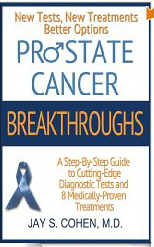Dr. Cohen’s New Book: 15 Prostate Cancer Breakthroughs: A New Era in Prostate Cancer Care Offers New Tests, New Treatments, Better Outcomes.
A quiet revolution in the diagnosis and treatment of prostate cancer is underway, but many doctors and most men diagnosed with prostate cancer have not heard about it. Instead, today men are quickly dispatched for aggressive treatment such as prostate surgery or radiation, both of which can affect men’s sexual or bladder competence permanently. The numbers are startling: 85% of men diagnosed with prostate cancer get surgery or radiation, yet only 15% actually need it.
I was diagnosed with prostate cancer in December 2011. Steered immediately toward radical treatment, the doctors said, “Your PSA is very high and your biopsy is positive, so your only alternatives are surgery or radiation.” Luckily I heard about the new methods and was able to avoid these aggressive treatments.
Yes, my PSA was high: 15 ng/ml. Normal is 4 or less. And my biopsy was positive, although the cancer is low grade. Just like me, surgery or radiation is what you likely will be told you need if your PSA is elevated even a little and your biopsy is positive for cancer.
But there are better tests today that can change the direction of treatment: color doppler ultrasound and, most of all, the advanced, prostate specific MRI. Until now, MRIs were not helpful because the prostate is situated so deep in the pelvis, the pictures were unclear and prostate cancer could not be identified. Now, the new MRI is highly accurate in identifying where the prostate cancer is and where it isn’t.
This made all of the difference for me. I learned that my prostate cancer was the size of the tip of my pinky in size, and located in a relatively safe area of the prostate with no sign whatsoever of spread. And because my cancer is slow growing, and my high PSA is likely from previous prostate infections, I am now doing active surveillance with my doctor. We are following the PSA levels and repeated the MRI in November. So far, so good.
In the past and still today, doctors have been very aggressive in treatment prostate cancer. They had little choice because there were no tests to identify the location and size of a man’s prostate cancer. So to avoid under treating men and allowing a cancer to spread, doctors recommended radical treatment for most men. This approach remains the mainstay. The revolution in prostate cancer care that has benefited me and other men so much remains unknown to most men diagnosed with prostate cancer today. Change happens slowly in medical care. It will probably take a decade for the advance, prostate specific MRI to become the standard of care.
You can a lot learn more about this in my new book, Prostate Cancer Breakthroughs: New Tests, New Treatments, Better Options (Oceansong Publishing 2013). Such as:
- Why you should get a PSA test annually.
- 20 questions to ask your doctor about prostate cancer.
- Where to obtain the new prostate specific MRI and color doppler ultrasound.
- New treatments that are available now.
- What are focal treatment and active surveillance, and are you a candidate?
- 7 additional breakthroughs that are emerging today.
- Quotes from top experts and up-to-date studies
Below is the table of contents. Prostate Cancer Breakthroughs
Section 1: Obtaining a Thorough Diagnostic Evaluation
- Step 1: The PSA Test
- Step 2: Blind Biopsy or Targeted Biopsy?
- Step 3: Assessing Your Findings
- Step 4: The Voice of Experience: The Support Group
- Step 5: The New, Advanced Prostate MRI
- Step 6: Color Doppler Ultrasound
Section 2: Treatment Options
- Chapter 7. Prostatectomy
- Chapter 8. Radiation Therapy and Brachytherapy
- Chapter 9. High Intensity Focused Ultrasound (HIFU)
- Chapter 10. Cryotherapy
- Chapter 11. Focal Therapy
- Chapter 12. Active Surveillance
Section 3: Weighing the Evidence and Making a Decision
- Chapter 13. What Does Your Data Say?
- Chapter 14. 7 New Breakthrough Methods Arriving Soon

Dr. Cohen is an Associate (Voluntary) Professor of Preventive Medicine and Psychiatry at the University of California, San Diego, one of the top 20 universities in America. His work in the area of preventing medication side effects has been widely published and is recognized nationally. If you would like Dr. Cohen’s input on your EM, he is available for office or telephone consultations. He charges a fee for his time, just as he charges people with other medical conditions who come to his office or consult with him from around the world. For information, contact Leslie at 858-345-1760 or schle@att.net.
NOTE TO READERS: The purpose of this E-Letter is solely informational and educational. The information herein should not be considered to be a substitute for the direct medical advice of your doctor, nor is it meant to encourage the diagnosis or treatment of any illness, disease, or other medical problem by laypersons. If you are under a physician’s care for any condition, he or she can advise you whether the information in this E-Letter is suitable for you. Readers should not make any changes in drugs, doses, or any other aspects of their medical treatment unless specifically directed to do so by their own doctors.
If you find this article informative, please tell your friends, family members, colleagues, and doctors about www.MedicationSense.com and the free MedicationSense E-Newsletter.
Category: Articles and Reports
